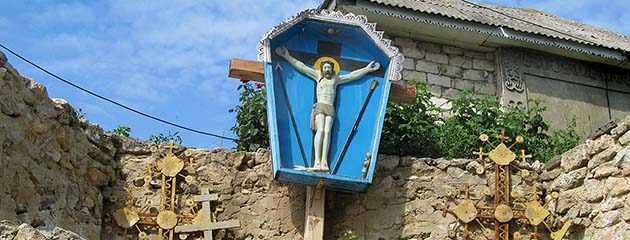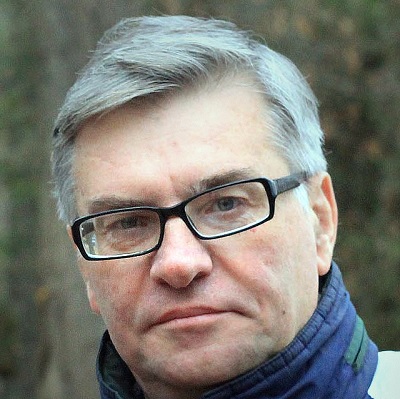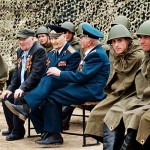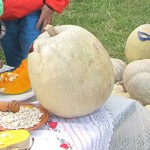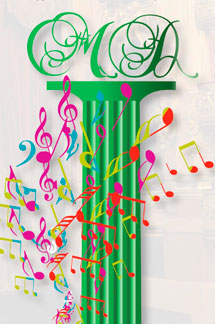Трушенская церковь Архангела Михаила. Самый большой сельский храм Молдовы. Белая, строгая, только что отстроенная, с высокой прямоугольной колокольней. Позолоченные кресты куполов отражают острые солнечные лучи. Сооруженная на склоне холма, церковь царствует над селом: отсюда оно отсюда, как на ладони, – из-за круглых крон фруктовых деревьев выглядывают аккуратные красные, синие, серые крыши сельских домов. Главная улица, петляя по селу, взбирается вдоль домов и участков на противоположный холм, и, исчезая за стройным рядом тополей и орехов, невидимая, убегает к кишиневской трассе. Столица от Трушен недалеко, с церковной колокольни видны ее многоэтажки.
В Трушенах любой местный житель знает и, если попросят, расскажет историю местного храма. Там, где сейчас поднимаются купола нового трушенского Божьего дома, 500 лет стояли местные православные церкви. Одна сменяла другую – от деревянных к каменным. Последнюю, перед возведением новой, церковь построили в 1869 году.
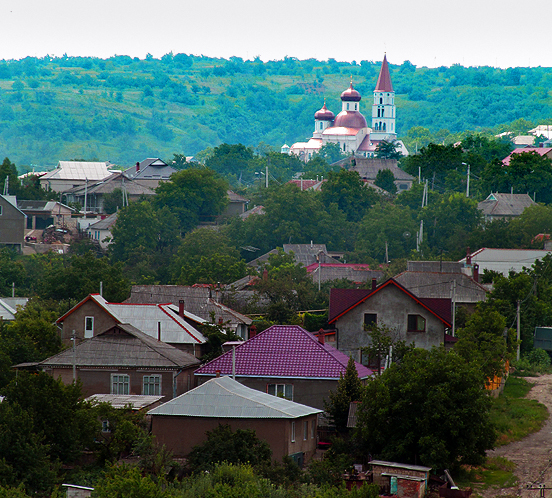
К началу нового тысячелетия – годы, землетрясения – церкви требовался капитальный ремонт. Ее настоятель, отец Андрей, давно вынашивал планы по ремонту церкви, но недоставало нужной суммы. Возможно, так бы и стояла старая церковь до сих пор, если бы не случай – особый, необычный.
В начале 2000-х годов православные верующие Австралии обратились к московскому патриарху, с просьбой найти им молодого священника, который бы свободно владел английским, русским и молдавским (румынским) языками. Объяснялась такая просьба просто: в крупнейшем городе Австралии – Мельбурне, всего три православных прихода. Прихожане – русские, украинцы, белорусы, владеющие русским языком, и румыны. Ну, а английский – государственный язык Австралии. В патриархате, недолго думая, обратились в митрополию молдавской православной церкви. Оказалось, что трушенский священник, отец Андрей, соответствует всем заявленным требованиям. Батюшка был только «за». Он понимал – для него это шанс собрать деньги на восстановление трушенской церкви.

В громадном австралийском мегаполисе отец Андрей не забыл родное село. При первом удобном случае он обратился к прихожанам – помочь пожертвованиями на восстановление церкви далекого от Австралии молдавского села. Среди прихожан оказались весьма обеспеченные люди, которым он подробно рассказал о своей главной цели – восстановлении трушенского храма. Бизнесмены подумали – и согласились. Часть денег дали и простые прихожане.
Отслужив в Австралии четыре года, в 2005 году батюшка вернулся в родное село. Австралийские православные – болгары, русские, украинцы, белорусы, молдаване и румыны – собрали на восстановление храма почти миллион долларов. Все деньги перечислялись на специальный счет. Помогли пожертвованиями и жители Трушен. После подсчетов и составления сметы оказалось, что на собранные деньги можно не просто капитально отремонтировать старый храм, но и перестроить его в новый. И не просто в новый. Собранная сумма позволяла перестроить старую церковь в самый большой сельский храм в Молдове. «Почему бы и нет? – думал батюшка, – когда еще представится такой случай! Трушенцы будут только рады».
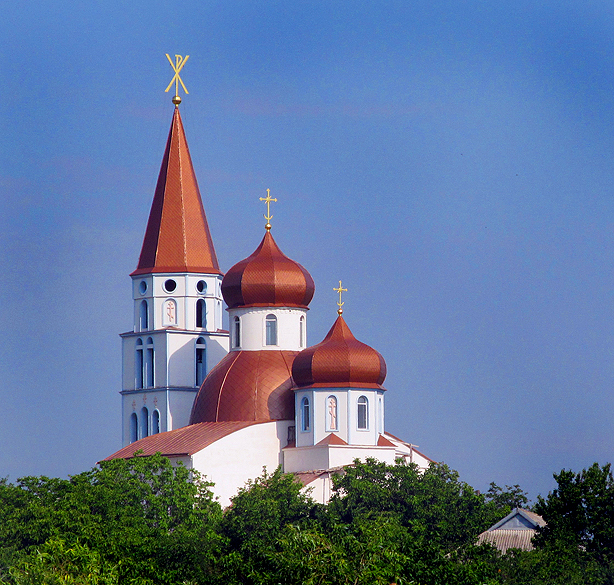
Именно перестроить, а не возводить новый. Архитектурной ценности старая церковь не представляла, но под церковью расположено подвальное помещение, в котором похоронены ктиторы (попечители) и священники трушенской церкви. Да и стены старой церкви, поднятые 150 лет назад, вполне крепкие, и могут простоять не одно столетие. Зачем их сносить, и возводить новые? Ведь на эти деньги можно благоустроить и расширить всю территорию, прилегающую к храму Архангела Михаила.
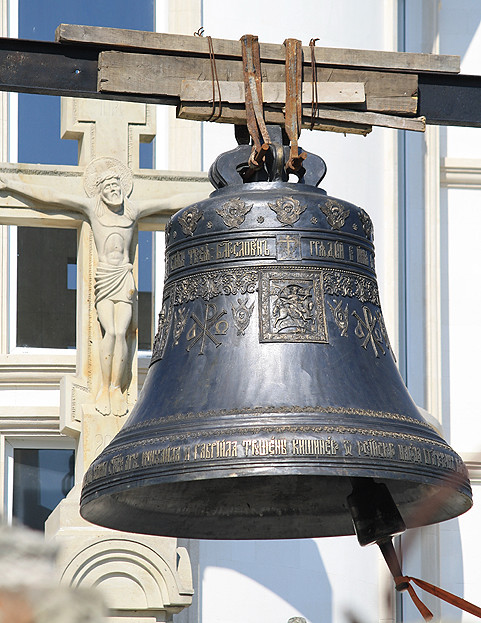
Здание старой церкви расширили – добавили пространства к алтарной части и удлинили общий зал с притором. В большие праздники в зале может собраться до тысячи прихожан. Но главное – пристроили колокольню. Она чем-то напоминает колокольни итальянских церквей эпохи Возрождения, словно символизируя возрождение церкви села Трушены.
Ее высота – 55 метров, а сама церковь удлинилась с 54 до 77 метров.

Отец Андрей сразу решил: внутренний двор церкви хорошо бы тоже благоустроить – он должен быть красивым. Первое, что бросается в глаза – газоны. Их несколько, все в цветах – белых, синих, светло-красных. А у стены газоны поднимаются двумя террасами. Даже на каменном заборе цветы – его тесно обвило красивое вьющееся растение с ярко-оранжевыми цветами, в форме длинных колокольчиков. Это кампсис – сегодня такое растение можно встретить почти в каждом трушенском дворе.
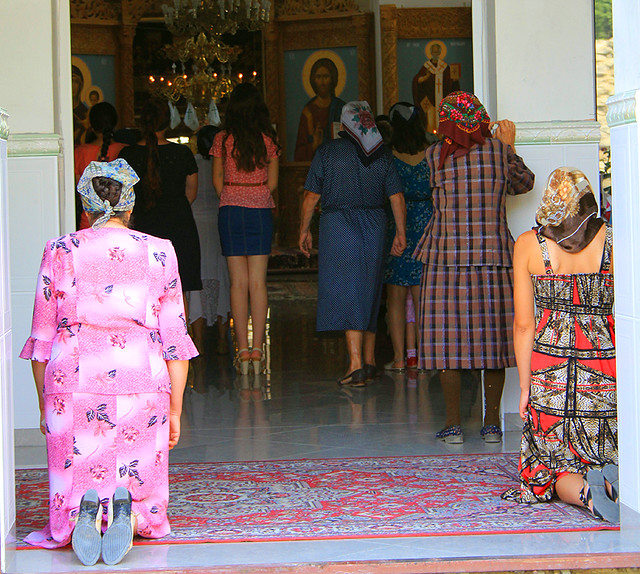
Позади церкви, ниже по склону от выложенной фигурной плиткой площадки, спускаются запущенные, заброшенные огороды, небольшие фруктовые сады, и зияют пустыми окнами несколько заброшенных сельских домов. «Отец Андрей специально купил эти участки у местных жителей, – рассказала Валентина Мадан, местная прихожанка, свекор которой, ктитор Леон Мадан, похоронен в усыпальнице под церковью. – В старину возле церквей обычно разбивались парки или сады, вот настоятель и решил возродить эту традицию. Церковь со своим парком – я думаю, это будет прекрасно».
Фото Олега Таценко и Алекса Димитрова.
Олег ТАЦЕНКО
Статья любезно предоставлена журналом Altitude — Air Moldova
English version: “Australian” church in Trusheni
The church of Michael the Archangel in Trusheni. It is the largest rural church in Moldova. White, austere, recently constructed. With the high, root-square bell tower. The gold-plated crosses of the domes reflect the sharp sun rays. Erected at the slope of a hill it reigns over the village. From here the settlement spreads out before you and one can see the accurate red, blue and grey roofs of the rural houses peering out from the roundish heads of the fruit trees. The main street winding through the village climbs up far and wide along the houses and plots at the opposite hill; and, disappearing behind the symmetric row of poplars and walnut trees, becomes invisible and runs away to the Chisinau route. The capital is not far away from Trusheni – its tower-blocks are seen from the bell tower of the church.
Every local resident of Trusheni knows and, if asked, will narrate the history of the local temple. The Orthodox churches stayed for more than 500 years at this place, where the domes of the new Trusheni Holy house are erected now. One succeeded the other – altering from wooden constructions to the stone ones. The last church that was here before erecting the new one was constructed in 1869.

To the beginning of the new millennium due to the years, earthquakes, etc. the church required the capital renovation. Its prior, Father Andrew, for the long time nurtured the plans on its reconstruction. However, the lack of necessary funds impeded it. Perhaps, the old church would stay until nowadays, if it was not for one occasion – the happy and unusual one.
In the beginning of bymillenary, the orthodox faithful of Australia addressed the Moscow Patriarch with the request to find for them a young priest who would fluently speak three languages – English, Russian and Moldovan (Romanian). This request was easy to explain – the largest city of Australia, Melbourne, hosts only three orthodox parishes. Their congregation includes Russians, Ukrainians and Byelorussians who speak Russian, as well as Romanians. As for English, this is the state language in Australia. Without thinking twice, the Patriarchy addressed this question to the metropolitan of the Moldovan Orthodox Church. And it appeared that the priest from Trusheni, Father Andrew, corresponded to all these requirements. The father was only glad – he understood that this was his chance to collect funds for the renewal of the Trusheni church.

Staying in the huge Australian city Father Andrew did not forget about the home village. Under the first convenient occasion he addressed the congregation with appeal to donate for renewal of a church in the Moldovan village that is very far from Australia. Among others, the church members included some well-heeled people, to whom he narrated in details about his main aim – renovation of the Trusheni church. The businessmen thought hard and… agreed to help. Part of money was gifted by the regular church members.
Having held the service in Australia for four years, in 2005, the Father came back to the home village. The Australian Orthodox Christians – Bulgarians, Russians, Ukrainians, Byelorussians, Moldovan and Romanians – collected almost one million dollars for the church renewal. All funds were transferred to the special account. The residents of Trusheni also helped with donations. After the calculations and making a cost sheet, it appeared that money collected allow not only to renovate the old church, but to reconstruct it into the new one. And it would be not simply a new church. The funds collected made it possible to turn the old church into the largest rural temple in Moldova. “Why not? – thought the Father. – When would we get another chance like this?! The residents of Trusheni would be only happy.”

The idea was not to erect the new building, but to rebuild the old one. The old church was not of great architectural value. However, it had the basement, where the church wardens and the priests of the Trusheni church were buried. Besides, the walls of the old building erected about 150 years ago are still strong and solid and can serve more than one century. What for getting rid of them and constructing the new ones? This money could be used for improvement and expansion of the territory of Michael the Archangel church.

The building of the old church was enlarged – the space was added to the altar and the general hall was lengthened. At the large holidays the hall can house about one thousand church members. However, the main thing was the construction of the bell tower. It reminds a little the bell towers of the Italian churches from the Renaissance era, as if it symbolizes the renaissance of the church of Trusheni village. It is 55 meters high; and the church itself elongated from 54 to 77 meters.

Father Andrew decided from the first moment: it would be good to develop the church yard – it should be also beautiful. The first that meets the visitors are the lawns. There are a couple of them – all with white, blue and light-red flowers. Closer to the wall the lawns turn into two terraces. The flowers are even at the stone fence, which is clasped over with a beautiful clambering plant with brilliant orange blossom trusses in the form of long bellflowers. It is trumpet creeper and today it can be seen almost in each yard in Trusheni.

Behind the church, down to the slope from the ground inlaid with shaped tiles there are abandoned and uncared vegetable lots, little fruit gardens and some uninhabited houses that yawn with the empty windows. “Father Andrew intentionally bought these land plots from the local people, – tells Valentina Madan, a church member, whose father-in-law, church warden Leon Madan is buried in the table tomb under the church. – In the old times, the parks or gardens were laid out by the churches. The prior decided to revive this tradition. The church with its own park… I think it will be lovely.”
Oleg TATSENKO
The article was provided by the magazine Altitude – Air Moldova

